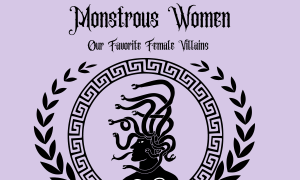
What makes a monster? Is it creatures depicted with gruesome physical characteristics such as excess limbs, sharp teeth, and scaly skin? Or are they human-like, our favorite vampires and werewolves that change appearances on a whim, monsters that hold eldritch origins but have since become something to pine after. Attractive or ugly, big or small, a monster has no clear definition. Despite this, many monsters have been gendered, exaggerating masculinity and/or femininity to appear as something to be horrified of or as something that is meant to please an audience by sexualizing them. Women, specifically, have taken on a unique type of monstrosity through literary history that has rapidly developed and metamorphosed over time. Whether it be a monstrosity physically defined as animalistic or humanistic, female villainy permeates the sphere of literature and has since the early ages of storytelling.
Depending on who you ask, Eve in the biblical story of Adam and Eve is one of the first female villains to have existed. By nature she is salacious and duplicitous, abiding by her own wants and needs over mankind. If a woman cannot bare to control her own desires, would that not make the perfect villain—selfish, malicious, and beguiling? To parallel, one might look at the story of Pandora’s box, unable to control her curiosity and intent to expand her knowledge, Pandora doomed the world by opening the box and unleashed hell upon earth. In Hesiod’s Works and Days, Pandora is blamed for all the wrongdoings that happen upon the earth and its people. There are countless instances of women portrayed as monsters, though they don’t all carry the same imagery of villainy. There’s Grendel’s mother in Beowulf, Scylla and Circe from The Odyssey and as such Helen from The Iliad. We can examine the works of Shakespeare—Lady Macbeth from Macbeth; Goneril from King Lear, and Sycorax from The Tempest. Often times these characters are the manifestations of misogyny, designed into flesh and bone so that men may lay blame on something tangible, on anyone except themselves.
As literature and media progresses and female characters have been wrung dry through a variety of archetypes such as the femme fatal, in recent years things have started to change. Many authors now are looking to reclaim disastrous femininity and sexuality by writing monstrous women in a different light. Let’s take a look at some of those books:
Monstress by Marjorie Liu
Monstress is high fantasy/sci-fi graphic novel series that follows protagonist Maika and her journey through self-discovery and struggling to come to terms with her trauma from war. The art style is delectable and brings to life a futuristic and steampunk version of 1900’s Asia.
Carmilla by J. Sheridan Le Fanu
Bram Stoker’s Dracula is often touted as the first vampire novel to ever be written. However, that statement is false. Carmilla by J. Sheridan Le Fanu was written decades before Dracula and features the obsessive and eerie Carmilla the vampire. She is dead-set on claiming Laura as her own after Laura seeks refuge in Carmilla’s home after her carriage crashes. Otherworldly, thrilling, and disastrous, Carmilla will satisfy any reader’s vampire needs.
Fledgling by Octavia Butler
If you can’t get enough of the undead, Octavia Butler’s Fledgling will serve as another fix. Shori is not a normal young girl, not only is she a creation that has been genetically modified, but she is also a 53-year-old vampire. Dedicated to finding out who made her this way, where she came from, and a past she does not entirely remember, Butler’s evocative writing will have any reader flying through this book.
Pandora’s Jar: Women in the Greek Myths by Natalie Haynes
As mentioned in the introduction, women in Greek myths do not necessarily have the greatest representation. Told through the perspective of men, many of the women and female villains in these stories have been twisted and bound by the constraints of sexism. Natalie Haynes in Pandora’s Jar commits to writing the stories of these characters in a fairer light while removing the glorification of the men in Greek myths. She retells the lore of Hera, Aphrodite, Circe, and Medea to name a few. Opening Pandora’s jar in this case will not bring about the destruction of the world, rather it will open the possibility of women achieving freedom through power.
As tantalizing as female villains and monsters are, truth is they are rarely accurately characterized under this stereotype. While Machiavellian villains happen to be women at times, it is just as exciting to see women play the antihero without falling under the weight of misogyny and sexism. Heavy as the weight may be throughout history, mostly modern feminist takes have approached and dominated new age literature. And it’s about time we get to reading them!
This blog was written by Yasmene S. and first appeared August 2022.



Add a comment to: Monstrous Women: Our Favorite Female Villains